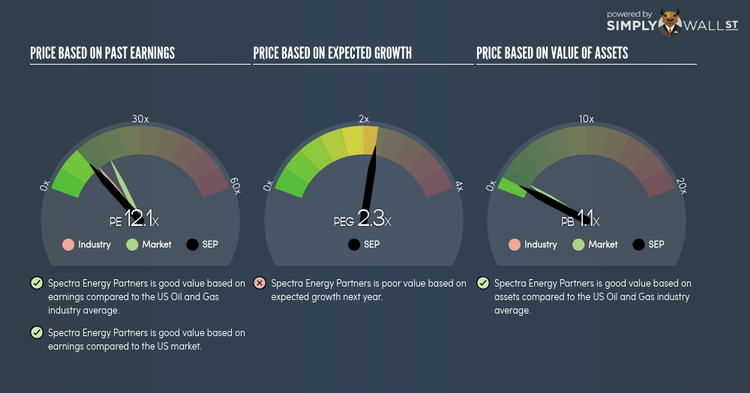Is Spectra Energy Partners LP’s (NYSE:SEP) PE Ratio A Signal To Buy For Investors?

Spectra Energy Partners LP (NYSE:SEP) trades with a trailing P/E of 12.1x, which is lower than the industry average of 13.9x. While this makes SEP appear like a great stock to buy, you might change your mind after I explain the assumptions behind the P/E ratio. In this article, I will deconstruct the P/E ratio and highlight what you need to be careful of when using the P/E ratio. View our latest analysis for Spectra Energy Partners
Demystifying the P/E ratio
A common ratio used for relative valuation is the P/E ratio. By comparing a stock’s price per share to its earnings per share, we are able to see how much investors are paying for each dollar of the company’s earnings.
P/E Calculation for SEP
Price-Earnings Ratio = Price per share ÷ Earnings per share
SEP Price-Earnings Ratio = $40.45 ÷ $3.351 = 12.1x
On its own, the P/E ratio doesn’t tell you much; however, it becomes extremely useful when you compare it with other similar companies. We preferably want to compare the stock’s P/E ratio to the average of companies that have similar features to SEP, such as capital structure and profitability. A common peer group is companies that exist in the same industry, which is what I use. SEP’s P/E of 12.1x is lower than its industry peers (13.9x), which implies that each dollar of SEP’s earnings is being undervalued by investors. Therefore, according to this analysis, SEP is an under-priced stock.
Assumptions to be aware of
However, before you rush out to buy SEP, it is important to note that this conclusion is based on two key assumptions. The first is that our “similar companies” are actually similar to SEP, or else the difference in P/E might be a result of other factors. For example, if you are comparing lower risk firms with SEP, then its P/E would naturally be lower than its peers, as investors would value those with lower risk at a higher price. The second assumption that must hold true is that the stocks we are comparing SEP to are fairly valued by the market. If this is violated, SEP’s P/E may be lower than its peers as they are actually overvalued by investors.
To help readers see pass the short term volatility of the financial market, we aim to bring you a long-term focused research analysis purely driven by fundamental data. Note that our analysis does not factor in the latest price sensitive company announcements.
The author is an independent contributor and at the time of publication had no position in the stocks mentioned.

